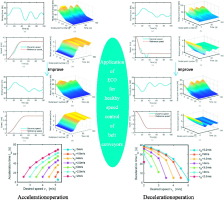当前位置:
X-MOL 学术
›
Powder Technol.
›
论文详情
Our official English website, www.x-mol.net, welcomes your
feedback! (Note: you will need to create a separate account there.)
Healthy speed control of belt conveyors on conveying bulk materials
Powder Technology ( IF 4.5 ) Pub Date : 2018-03-01 , DOI: 10.1016/j.powtec.2018.01.002 Daijie He , Yusong Pang , Gabriel Lodewijks , Xiangwei Liu
Powder Technology ( IF 4.5 ) Pub Date : 2018-03-01 , DOI: 10.1016/j.powtec.2018.01.002 Daijie He , Yusong Pang , Gabriel Lodewijks , Xiangwei Liu

|
Abstract Belt conveyors play an important role in the dry bulk material handling process. Speed control is a promising method of reducing the power consumption of belt conveyors. However, inappropriate transient operations might cause risks like material spillage away from the belt conveyor. The unexpected risks limit the applicability of speed control. Current studies on speed control mainly focus on designing energy models of belt conveyors or building control algorithms of variable speed drives, while rare researchers take into account the risks in transient operations and the dynamic performance of belt conveyors under speed control. The paper proposes an Estimation-Calculation-Optimization (ECO) method to determine the minimum speed adjustment time to ensure healthy transient operations. The ECO method is composed of three steps and takes both risks in transient operations and the conveyor dynamics into account. In the Estimation step, an estimator is built to approximate the permitted maximum acceleration by treating the belt as a rigid body. Taking the belt's visco-elastic property into account, the Calculation step computes the conveyor dynamics by using a finite-element-method. With respect to the risks in transient operations, the Optimization step improves the conveyor's dynamic behaviors and optimizes the speed adjustment time. A case of a long belt conveyor system is studied and the ECO method is applied. The secant method is also used to improve the optimization efficiency. According to the experimental results, the ECO method is successfully used to determine the minimum speed adjustment time to ensure healthy transient operations, including both the accelerating and the decelerating operations. With the suggested adjustment time, unexpected risks are avoided and the belt conveyor shows an appropriate dynamic behavior. Accordingly, the ECO method ensures healthy transient operations and improves the applicability of speed control with the consideration of the potential risks and the conveyor dynamics.
中文翻译:

输送散装物料时带式输送机的健康速度控制
摘要 带式输送机在干散装物料搬运过程中发挥着重要作用。速度控制是降低带式输送机功耗的一种很有前景的方法。但是,不适当的瞬态操作可能会导致诸如物料从带式输送机溢出等风险。意料之外的风险限制了速度控制的适用性。目前对速度控制的研究主要集中在设计带式输送机的能量模型或构建变速驱动器的控制算法,而很少有研究人员考虑到瞬态运行中的风险和速度控制下带式输送机的动态性能。本文提出了一种估计-计算-优化 (ECO) 方法来确定最小速度调整时间,以确保健康的瞬态操作。ECO 方法由三个步骤组成,同时考虑了瞬态操作中的风险和输送机动力学。在估算步骤中,通过将皮带视为刚体来构建估算器以近似允许的最大加速度。考虑到皮带的粘弹性,计算步骤使用有限元方法计算输送机动力学。对于瞬态操作中的风险,优化步骤改进了输送机的动态行为并优化了速度调整时间。研究了一个长带式输送机系统的案例,并应用了 ECO 方法。割线法也用于提高优化效率。根据实验结果,ECO 方法成功地用于确定最小速度调整时间,以确保健康的瞬态操作,包括加速和减速操作。通过建议的调整时间,可以避免意外风险,并且带式输送机显示出适当的动态行为。因此,ECO 方法可确保健康的瞬态操作,并在考虑潜在风险和输送机动态的情况下提高速度控制的适用性。
更新日期:2018-03-01
中文翻译:

输送散装物料时带式输送机的健康速度控制
摘要 带式输送机在干散装物料搬运过程中发挥着重要作用。速度控制是降低带式输送机功耗的一种很有前景的方法。但是,不适当的瞬态操作可能会导致诸如物料从带式输送机溢出等风险。意料之外的风险限制了速度控制的适用性。目前对速度控制的研究主要集中在设计带式输送机的能量模型或构建变速驱动器的控制算法,而很少有研究人员考虑到瞬态运行中的风险和速度控制下带式输送机的动态性能。本文提出了一种估计-计算-优化 (ECO) 方法来确定最小速度调整时间,以确保健康的瞬态操作。ECO 方法由三个步骤组成,同时考虑了瞬态操作中的风险和输送机动力学。在估算步骤中,通过将皮带视为刚体来构建估算器以近似允许的最大加速度。考虑到皮带的粘弹性,计算步骤使用有限元方法计算输送机动力学。对于瞬态操作中的风险,优化步骤改进了输送机的动态行为并优化了速度调整时间。研究了一个长带式输送机系统的案例,并应用了 ECO 方法。割线法也用于提高优化效率。根据实验结果,ECO 方法成功地用于确定最小速度调整时间,以确保健康的瞬态操作,包括加速和减速操作。通过建议的调整时间,可以避免意外风险,并且带式输送机显示出适当的动态行为。因此,ECO 方法可确保健康的瞬态操作,并在考虑潜在风险和输送机动态的情况下提高速度控制的适用性。











































 京公网安备 11010802027423号
京公网安备 11010802027423号